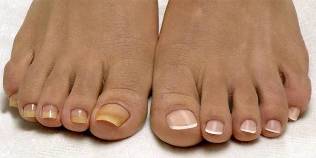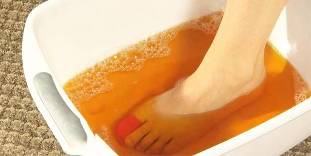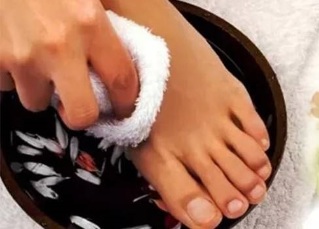There are many non-standard tools for the treatment of fungal infections: iodine solution, garlic, Apple cider vinegar. Similar actions have and hydrogen peroxide fungus toenails: according to the reviews, this tool can cure even advanced cases of the disease. Fans of this method argue that you can kill the fungus and antiseptic. Supporters of traditional medicine rather narrow means, antifungal activity.

What is fungus toenails
Medical name of the disease – onychomycosis. It is called fungi-dermatophytes of the genus Trichophyton, Epidermophyton and, less frequently, substances microsporia (ringworm). Fungal infection, the nail plate – it is not a cosmetic defect, it is a serious disease, which has its own code according to the international classification of diseases ICD-10. Nail fungus can capture a portion of the nail plate or the entire nail (then, doctors call it total). The currently accepted classification of the appearance of the nail (the web you can find pictures of):
- normotroficheskie – stripes, spots while retaining the traditional shape and thickness of the nail;
- hypertrophic – plate grows outwards, change colour, lose gloss, thickens, begins to crumble;
- the fungus – affected part dies and is rejected from the bed.
Onychomycosis only to get infected, so it is very common: according to studies, the disease occurs in about 27% of the European population. Route of transmission – public locker rooms, saunas, swimming pools. The older a person is, the greater the probability of infection. At risk are patients with psoriasis and diabetes, these infection "sticks" is much more likely.
The treatment of nail fungus with hydrogen peroxide
Fungal infections, must be distinguished from non-fungal infections of the nail plate. You can do this dermatologist with the help of analysis, which takes place in hospitals and private laboratories. On this basis, you can choose the right drug for the various funds, the purpose of which is to improve the fungal, as well as pharmacy and national. Special attention deserves the treatment of fungal toenails with hydrogen peroxide.
The normal antiseptic, which is all one can surprise the width of the spectrum. In addition, treatment of wounds, it can be used to disinfect surfaces in the house, teeth whitening, solution, ear plugs. Treatment of fungal nails with hydrogen peroxide, perhaps due to its property of softening and separating the healthy tissues nekrotizirovannye areas.
How to with vinegar
Fungicidal acidic environment, so in many folk recipes running to lose treated with a solution of vinegar. There are several ways to use vinegar and peroxide fungus toenails:
- Pack diluted in equal proportions with three percent hydrogen peroxide and vinegar. The mixture, which is characterized by the smell of rich soaked cotton swab, which should be applied to the affected nail. Have to pack up until the end whistle. Repeat each morning and evening during the month.
- Paste of vinegar and baking soda. You need to take two tablespoons of baking soda and water and one part vinegar and peroxide. The resulting paste should be applied to the affected nails a day to 2 times, lasts 15-20 minutes, then rinse.
- A foot bath of vinegar with water, adding hydrogen peroxide. The concentration of peroxide and vinegar per liter of warm water with two tablespoons of. Such baths for 15 minutes twice a week is relapse prevention.

The treatment of nail fungus with hydrogen peroxide according to Neumyvakina
Ivan Pavlovich – doctor, who is the author of several non-traditional methods for healing the body, including with the help of hydrogen peroxide. This antiseptic, the Professor believes, can kill pathogens in the intestinal and treat serious systemic disease in humans. Apply peroxide to his method, is recommended, both internally and externally.
Treatment of fungal toenails with hydrogen peroxide, the author intends to do an external application. Steamed warm soda solution (two tablespoons diluted in a liter of water) nails need to impose cotton swabs soaked in peroxide, let stand for 30 minutes. To repeat a day until it goes away symptoms. According to some estimates, although very hard running the sponge in the lower limbs in this way can be improved.
Baths hydrogen peroxide
Traditional medicine considers treatment of toe nail fungus with hydrogen peroxide as an adjuvant. Dermatologists suggest technology with treatment: the first use peroxide, it will help soften the nails and then apply the antifungal drugs. A liter of warm water must be dissolved 50 ml, put it on a tray on foot. The treatment lasts a quarter of an hour. Nails are cut and applied to the prescribed by a doctor tool. The procedure does not cause discomfort. You can make a compress on the affected nail.
Baths with baking soda, salt, hydrogen peroxide and vinegar
Hydrogen peroxide vs nail fungus on the feet is to use foot baths along with the baking soda softening, salt add disinfectant, vinegar – to ensure an acidic environment, which kills the fungus. Several recipes using epsom salt (magnesium sulfate is sold in pharmacies). The ingredients you need to mix in equal proportions and dissolved in warm water. The main result of this bath should be softening, but not a complete recovery from the fungus.
Prevention of re-infection

So the fungus has not returned, during treatment should pay attention to the disinfection of shoes and socks, otherwise it is a constant self-infection. There are other simple rules of prevention of relapse:
- Shoes according to size and season. It is desirable to give preference to natural materials (leather, suede).
- It is important to let the shoes dry out after use, preferably on a daily basis.
- Swimming pool, sauna, gym spores of the fungus protect the individual rubber Slippers.
- Pedicure and manicure should not be done, if there is no confidence in the safe disinfection of instruments in the oven.
- Dry feet after washing, moisture the toes of the intervals contributes to the spread of infection.
- To strengthen the overall immune system – it affects disease susceptibility.





























